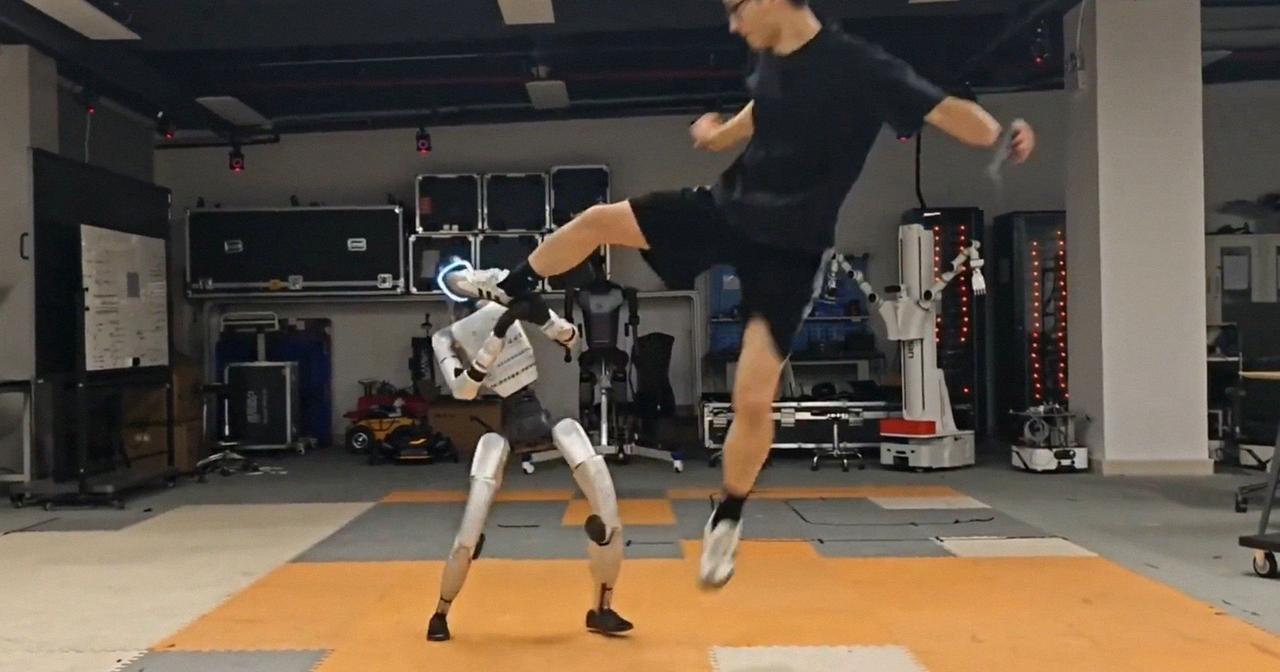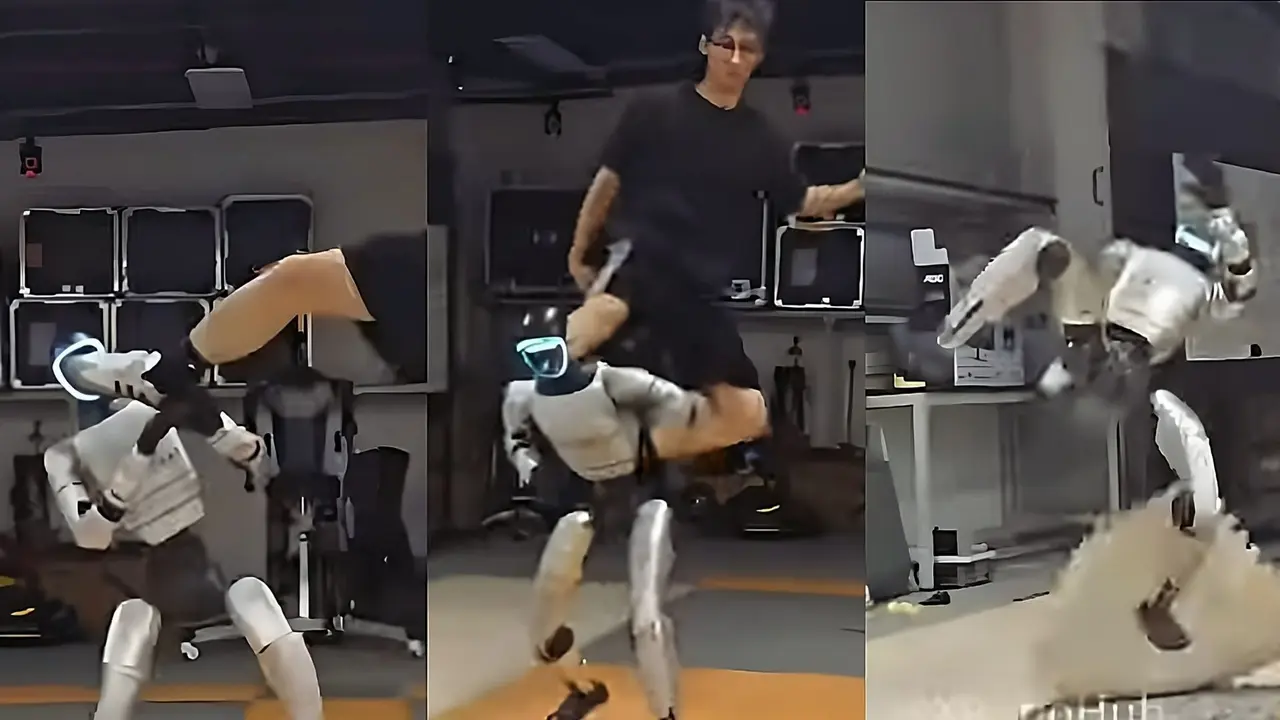China's Humanoid Robot G1 Withstands 'Violence Test' in Viral Video
3 Sources
3 Sources
[1]
Video shows China's humanoid robot enduring 'violence test'
In this video the humanoid robot is shown undergoing what the uploader called a "violence test." In the clip, a demonstrator repeatedly kicks the robot to test its balance, coordination, and durability, an approach that may look harsh, but is a common method among manufacturers and roboticists to evaluate stability and resilience. In the opening seconds, the G1, known for its lightweight frame and flexibility, is seen kicking the air while apparently under remote control. Just moments later, the robot slips on a carpet and collapses to the ground, only to spring back upright in less than a second. That quick recovery is a certified "WHAT?" moment. Notably, this is the only fall the robot suffers throughout the video, and even then it appears to be caused by the surface beneath its feet rather than the kicks themselves. Over the course of the short video, the demonstrator kicks the robot roughly nine times. The blows come from front, back, and the demonstrator doesn't seem to hold back even. Despite the repeated shoves, the G1 manages to keep its balance and posture, occasionally swaying or losing footing but quickly regaining control. The video's comment section is filled with sarcasm. One user wrote, "When the AI overlords come that guy is the first to go," while another warned, "Remember kids, one day these robots will be watching these videos too." The robot's punching and kicking motions, which often seemed directed away from the demonstrator. As one noted, "All it needs is a target tracking system, he's finished."
[2]
Unstoppable Martial Arts Robot Can Take a Direct Dropkick Without Falling Down
A new viral video shows a kickboxing humanoid robot shrugging off a flying dropkick from a human being. The research behind the stunt was conducted by scientists at the Active Intelligent Systems (ACT) Lab at the Southern University of Science and Technology (SUSTech) in Shenzhen, China, using Unitree's popular G1 robot. The robot's incredible agility highlights how far the tech has come in a matter of years. Chinese robot manufacturer Unitree's G1, in particular, has quickly turned into a popular test bed for reinforcement learning techniques, allowing it to pick up new skills very quickly. In fact, the only thing that even came close to defeating the robot in the video was a loose tile that tripped it up -- and even in that case, it made an impressive recovery, jumping right back up to fight some more in less than a second. We've already seen the G1 show off its martial arts prowess several times, from punching the air and delivering a swooping roundhouse kick to two of the bots facing off in a kickboxing showdown event at the World AI Conference in Shanghai last month. However, things can still go off the rails -- with alarming results. A video of a failed test run by robot combat company REK in July showed a G1 flailing its arms and legs, seemingly trying to break free of a harness. Others are using the robot for dramatically different purposes as well. Case in point, a cowboy hat-toting bipedal robot, dubbed "Jake the Rizzbot," has been wandering the streets of several US cities this summer, turning heads and flinging compliments -- instead of punches and kicks -- at passersby.
[3]
China's humanoid robot withstands martial arts kicks in viral 'violence test' video - VnExpress International
A viral YouTube video captures Unitree's G1 humanoid enduring repeated kicks in what researchers described as a "violence test" designed to challenge the boundaries of humanoid robotics. The experiment was conducted by scientists at the Active Intelligent Systems Lab at the Southern University of Science and Technology in Shenzhen, China, according to Futurism. In the opening scene, the G1, known for its lightweight frame and agility, performs kicking motions under remote control before slipping on a carpet and collapsing. It quickly springs back upright and withstands about nine strong kicks from a demonstrator. Despite swaying and losing footing at times, the robot consistently regains balance. Interesting Engineering noted that while the method may appear harsh, such stress tests are common among robot makers to evaluate balance, coordination, and durability. The unusual demonstration drew sarcastic reactions online. One viewer wrote, "When the AI overlords come that guy is the first to go," while another warned, "Remember kids, one day these robots will be watching these videos too." Some commenters joked about the robot's punching and kicking motions missing their target, with one saying, "All it needs is a target tracking system, he's finished." According to Unitree, the G1 stands 1.32 meters tall, weighs 35 kilograms, and is built for complex environments with smooth motion control and advanced computing power. It has drawn attention for performing tasks such as kip-ups and cooking, and for competing in what was billed as the world's first humanoid robot boxing tournament in May. The company's earlier model, the H1, previously sparked safety concerns after malfunctions during testing. In one U.S. lab incident, the robot swung uncontrollably while suspended from a crane, narrowly missing technicians, while a similar case was reported at a Chinese factory.
Share
Share
Copy Link
A viral video showcases the Unitree G1 humanoid robot enduring repeated kicks in a 'violence test', demonstrating its impressive balance and resilience. The experiment, conducted by Chinese researchers, highlights advancements in humanoid robotics and sparks discussions about AI's future.
Unitree G1: A Resilient Humanoid Robot
A viral video showcasing China's Unitree G1 humanoid robot undergoing a 'violence test' has captured the attention of tech enthusiasts and researchers alike. The experiment, conducted by scientists at the Active Intelligent Systems Lab at the Southern University of Science and Technology in Shenzhen, China, demonstrates the robot's impressive balance, coordination, and durability
1
3
.The 'Violence Test' Unveiled
In the video, the G1 robot, known for its lightweight frame and agility, is subjected to a series of physical challenges. The test begins with the robot performing kicking motions under remote control, showcasing its flexibility and range of motion
1
.The real test of its capabilities comes when a demonstrator delivers approximately nine strong kicks to the robot from various angles. Despite the forceful impacts, the G1 manages to maintain its balance and posture, occasionally swaying or losing footing but quickly regaining control
1
2
.
Source: Futurism
Impressive Recovery and Stability
One of the most striking moments in the video occurs when the G1 slips on a carpet and falls to the ground. In a display of remarkable agility, the robot springs back to an upright position in less than a second, demonstrating its advanced recovery capabilities
1
3
.
Source: Interesting Engineering
Technical Specifications and Applications
The Unitree G1 stands at 1.32 meters tall and weighs 35 kilograms. It is designed to operate in complex environments, boasting smooth motion control and advanced computing power. The robot has garnered attention for its ability to perform various tasks, including complex martial arts moves like kip-ups and even cooking
3
.Related Stories
Public Reaction and Future Implications
The video has sparked a range of reactions online, from humor to concern about the future of AI. Some viewers joked about potential scenarios where robots might retaliate against humans, while others marveled at the technology's rapid advancement
1
2
.This demonstration highlights the significant progress made in humanoid robotics in recent years. The G1's ability to withstand physical stress and maintain balance showcases the potential for these robots to operate in dynamic and unpredictable environments
2
.Safety Concerns and Previous Incidents
While the G1 has shown impressive capabilities, it's worth noting that earlier models from Unitree have raised safety concerns. The company's H1 model experienced malfunctions during testing, including an incident where it swung uncontrollably while suspended from a crane, narrowly missing technicians
3
.As humanoid robots continue to evolve, these 'violence tests' and stress evaluations play a crucial role in assessing their resilience and safety. The balance between pushing technological boundaries and ensuring human safety remains a key consideration in the rapidly advancing field of robotics.
References
Summarized by
Navi
[1]
Related Stories
Recent Highlights
1
AI Chatbots Sway Voters More Effectively Than Traditional Political Ads, New Studies Reveal
Science and Research

2
Trump signs executive order to override state AI laws despite bipartisan pushback
Policy and Regulation

3
OpenAI warns upcoming AI models will likely pose high cybersecurity risk with zero-day exploits
Technology








